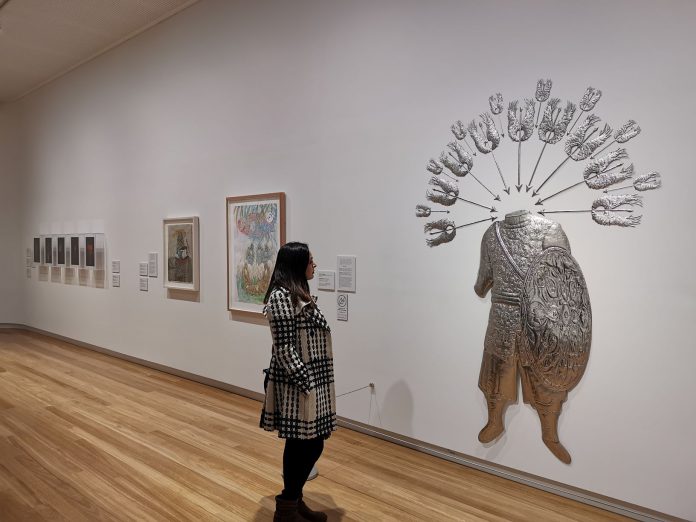It’s rare to find an entire exhibition devoted to South Asian artists – not only those who live and work in the Subcontinent, but also expats who live here in Australia. The ongoing exhibition at Melbourne’s Bunjil Place, Continental Shift: Contemporary Art and South Asia, is a welcome initiative, bringing together the work of fourteen artists.
The title ‘Continental Shift’ itself is a wonderful play on ideas, suggesting not only the origin of the artists and thinkers whose works are on display, but refers also to the swings that are taking place in identity. The works are explorations about the self; equally, they are statements about the societies in which we live – South Asia, Australia, the world at large.

Right at the outset, in the piece Sangeeta and Fuji, we see the issue of identity as made up of a number of different components. Durga – the warrior goddess, the invincible, and the undefeatable – gets a contemporary avatar in artist Kate Beynon’s work. The piece represents Beynon’s friend and fellow artist Sangeeta Sandrasegar as a modern day Durga who, according to Beynon, symbolizes ‘positive, feminine creative energy and a protective force’.
First exhibited at the Archibald Prize in 2014, the work seamlessly combines elements of Australian, Indian and Chinese cultures. Look closely and you’ll notice Sandrasegar holdingpainting tools in her left hand while the right symbolizes the Chinese gesture of greeting. Durga’s official rider, the tiger, gets a catty makeover to become Fuji, the painter’s cat.

Grappling with her own sense of identity, Fiji-born artist Shivanjani Lal’s fascinating video art is titled Kala Pani (literally ‘black water’, a term that describes how crossing the seas to
foreign lands leads to a loss of social respectability). Through the visual metaphor of hands, spices and water, Lal reimagines Kala Pani as a site of healing and reforming imagined identities. The work represents the artist’s internal dispute about the identity of her community, that she feels will always the bear the mark of India, the motherland of her forebears.

In ‘Speak No?’, Australian artist TextaQueen presents a self-portrait that reveals both discomfort and disconnect. In a rich amalgamation of colours, an urban monkey covers the artist’s mouth, and beautiful dupattas float in the background. Is our colonial history the proverbial monkey on the back that seems to be keeping us from flowering to our fullest?

Our sense of identity is inextricably bound with the place from which we come. Karachi-born artist Adeela Suleman, in her hand-beaten stainless steel sculpture The Warrior, draws parallels between childhood narratives and local mythologies in Northern India (where she grew up) and Pakistan (where she currently lives). Peacock feathers that morph into spears draw attention to the painful presence of violence in current day Pakistan.

Sounds of circuit boards and transmitters echo across the length and breadth of the room emanating from the exhibition’s centerpiece, Mumbai-based Reena Kallat’s Woven Chronicle. A magnificent installation of a world map made with plastic coated cables that refer to barbed wire, this is a contrasting reminder of impenetrable fences as well as a symbol of connectivity. The crisscross mesh of wires traces migration routes taken by various groups of people including refugees, contract workers, indentured labourers as well as professionals travelling for work; the speakers represent a constant transmission of ideas, information and people transcending boundaries.

In another work, a vibrant blue Vespa scooter attached to a colourful woven charpai (bed commonly found in rural India) inevitably catches your attention. This piece by Sydney-based Richard Goodwin called 1- √2 charpai for Mumbai showcases the artist and his friends Ishan Khosla and Trent Jansen’s socio-cultural and economic observation of Mumbai over three weeks. Here Goodwin creates a ‘high-rise bed on the move’ pondering on the lessons that Mumbai slums can offer 21 st century architecture and society. The installation also addresses the challenges of ever-expanding mega cities like Mumbai.

Meanwhile, there is also room for a bit of Australian history and identity. Monga Khan is an image that the Indian Australian community is well acquainted with, given we’ve seen it on the walls of city buildings for some time now. The image of this early settler from the subcontinent, a hawker by trade, and its proliferation in recent times, is a powerful statement of the early diversity of Australian culture.

At the very essence of it, the exhibition throws light on our evolving identities as individuals as well as communities. It prompts the question to ourselves, what continental shifts have
shaped our own narrative?
Continental Shift: Contemporary Art and South Asia is currently on at Bunjil Place, Narre Warren, until 22 September. Visit www.bunjilplace.com.au for more details.





